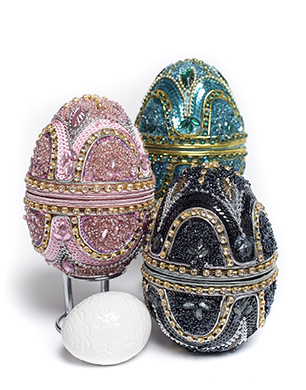
Photo Credit: marsjo via www.pixabay.com
Eggs have held a historical significance of giving rise to new life. Traditionally, they symbolised birth, and that is why a ton of mythical figures owed eggs for their existence.
Such instances are good reasons why original Faberge eggs have held a special place in society to date, akin to statues of notable figures all over the world. It is no wonder the Easter holidays chose eggs to mark the momentous occasion. Egg decorations date back to about 65000 years ago, meaning eggs have held a significant part of human civilisation for a long time.
While the significance of eggs to humans is still up for debate even today, it is believed the curvy nature of eggs has a comforting effect on those who hold them.
The Birth of Egg-Craft
Faberge eggs have a special relationship with the Easter holiday, and the story of this phenomenon dates back to the Roman Empire, when Christianity took over traditional, primitive forms of worship. Christianity dominated the Roman Empire gradually, and eggs were a common sight in religious festivities.
Colourful eggs gave a new meaning to the period of Easter for a lot of children who had to find them in a series of hide-and-seek games, giving birth to the modern ‘Easter Egg’ basket.
While the start of egg craft goes back a long time ago before the beginning of any meaningful civilization, Tsar Alexander is the first to have a golden egg art created, which later was gifted to his wife. The impressive present had an enamelled shell, which resembled a real egg. Further, the egg could break, with the insides presenting a hen held in the yolk.
Going deeper, the hen inside the yolk held a crown, which also took the shape of an egg. Noteworthy, the designers chose ruby to represent the pendant.
Indeed, the empress loved the gift, which moved the Tsar to have new eggs made every year.
Significant of Fabergé to Modern Art and Design
The name Fabergé is important when tracing the origin of modern art and design. Fabergé held a significant role in traditional Russian egg art and craft. The goldsmith was responsible for new egg designs that the Tsar desired for gift and personal fulfilment. His eggs became so popular that other European nations noticed. The goldsmith ensured he sent out at least two eggs annually, except during wartime.
The eggs are easily traceable to the Royal Palace in England, and the Faberge Museum in Russia, and the rest are in a private collection. However, some of the original Faberge eggs remain untraceable to date.
Places To See the Original Faberge Eggs
Faberge made a total of 40 eggs that have each found a new home since the end of their creation. Modern Russia is different from the traditional Tsar days, meaning most eggs in the country now lie in a museum for anyone to see. For their sizes, the eggs are one of the most expensive pieces of art.
The state of the eggs in the St Petersburg Museum provides a glimpse of how luxury art can transform the looks and feel of living spaces. In modern times, it is easier to have a piece of the Faberge eggs for a small price, since the originals fetch a handsome sum.
While places like Trinketgems and Amazon do not offer the real deal, they have impressive lookalikes that feel luxurious and will improve any part of real estate.
The rest of the original Faberge eggs are in private collections, away from public reach. Indeed, one of the most notable families in the world—the royal family—has a total of three eggs in their collection.
Closing Remarks
Eggs have been a significant part of human culture for a long time. Beyond them, serving as a constant staple in people’s diets, art, and design has made them attractive to interior design. The original Faberge was elegant—at least their current appearances in museums and other places where they exist confirm this. Indeed, for any art lover, the eggs remain a significant symbol of style and statement.

